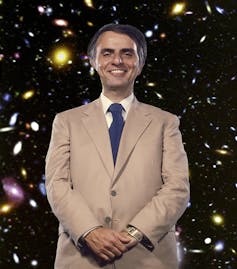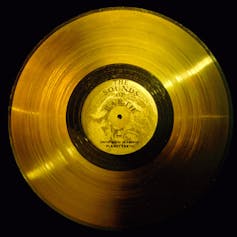Jamie Carter
Senior Contributor
Jamie Carter is an award-winning reporter who covers the night sky.
Nov 5, 2024

Jupiter, as seen during NASA Juno's 66th perijove on Oct. 23, 2024. NASA / JPL / SwRI / MSSS / Gerald Eichstädt / Thomas Thomopoulos © cc by
NASA’s Juno spacecraft has returned new images of Jupiter after its 66th close flyby as it enters the final year of its mission. The $1 billion spacecraft completed its latest close flyby on Oct. 23, 2024, dipping close to its poles, the first mission to do so.
Juno, which has been in orbit around Jupiter since July 2016, has sent back thousands of unprecedented high-resolution images of the planet’s atmosphere and several of its moons. It’s latest tranche are equally as spell-binding.

Jupiter, as seen during NASA Juno's 66th perijove on Oct. 23, 2024. NASA / SwRI / MSSS / Jackie Branc © cc by
During this latest flyby, the spacecraft passed close to Amalthea, Jupiter's fifth-largest moon, characterized by its potato-like shape and small size. With a radius of 52 miles (84 kilometers), it is significantly smaller than Earth's moon and orbits closer to Jupiter than Io.

A collage of images of Jupiter, as seen by NASA Juno during its 66th perijove on Oct. 23, 2024. NASA/JPL-Caltech/SwRI/MSSS/Brian Swift © cc by
MORE FROMFORBES ADVISOR
Best High-Yield Savings Accounts Of 2024By
Kevin Payne
Contributor
Best 5% Interest Savings Accounts of 2024By
Cassidy Horton
Contributor
Its two-megapixel camera, JunoCam, continues to capture images that reveal intricate details of Jupiter’s weather patterns, including its colorful bands and storms. Besides JunoCam, the spacecraft has a magnetometer, a gravity science system and a microwave radiometer.
Forbes Daily: Join over 1 million Forbes Daily subscribers and get our best stories, exclusive reporting and essential analysis of the day’s news in your inbox every weekday.
Get the latest news on special offers, product updates and content suggestions from Forbes and its affiliates.
By signing up, you agree to our Terms of Service, and you acknowledge our Privacy Statement. Forbes is protected by reCAPTCHA, and the Google Privacy Policy and Terms of Service apply.

Jupiter, as seen during NASA Juno's 66th perijove on Oct. 23, 2024. NASA / SwRI / MSSS / Jackie Branc © cc by
Remarkably, the Juno mission has no dedicated team of image-processing scientists. Instead, citizen scientists download the raw data — which JunoCam captures as it spins — who painstakingly process them and upload them to a dedicated mission website, many of them in creative versions.

Jupiter, as seen during NASA Juno's 66th perijove on Oct. 23, 2024. NASA / JPL / SwRI / MSSS / Gerald Eichstädt / Thomas Thomopoulos © cc by
There are now two missions on their way to the gas giant planet to replace Juno. Jupiter’s moon Callisto will be imaged 21 times during close flybys by the European Space Agency's JUICE spacecraft, which launched last year and will reach the Jovian System in 2031.

Jupiter, as seen during NASA Juno's 66th perijove on Oct. 23, 2024. NASA / SwRI / MSSS / Jackie Branc © cc by
JUICE will also photograph Europa before eventually going into orbit around Ganymede for 18 months. NASA’s Europa Clipper, launched earlier this month, will reach Jupiter in 2030 to tour Jupiter’s moons, focusing on Europa.
Juno’s next close flyby of Jupiter, perijove 66, will occur on Nov. 25, 2024. The Juno mission is scheduled to end on Sept. 15, 2025, when Juno will perform a “death dive” into the gas giant during its 76th perijove to be destroyed. This will ensure it doesn't crash into one of the moons of Jupiter that could potentially host life, specifically Europa.
Wishing you clear skies and wide eyes.

Jamie Carter
Jamie Carter is an award-winning reporter and experienced stargazer who covers the night sky, astro-tourism, the northern lights and space exploration..
Demand for observing time on Webb outpaces supply by a factor of nine.
Stephen Clark – Nov 6, 2024
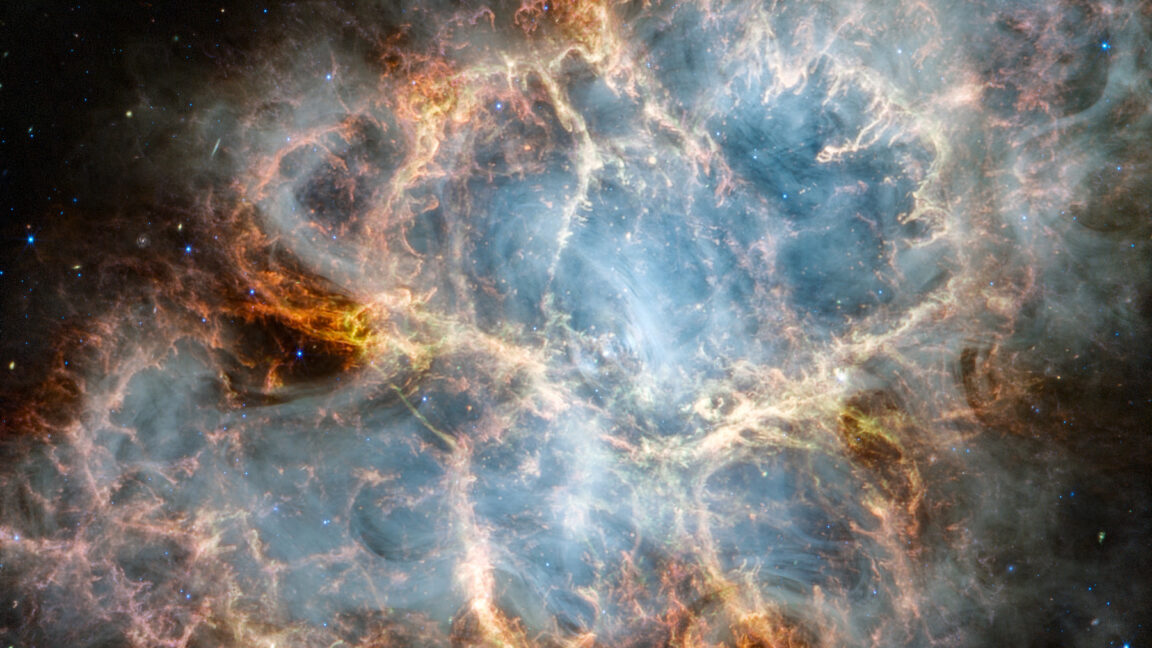
Astronomers combined images from two of Webb's infrared science instruments to create this view of Crab Nebula, the remnants of a violent supernova explosion in 1054. Credit: NASA, ESA, CSA, STScI, T. Temim (Princeton University)
From its halo-like orbit nearly a million miles from Earth, the James Webb Space Telescope is seeing farther than human eyes have ever seen.
In May, astronomers announced that Webb detected the most distant galaxy found so far, a fuzzy blob of red light that we see as it existed just 290 million years after the Big Bang. Light from this galaxy, several hundreds of millions of times the mass of the Sun, traveled more than 13 billion years until photons fell onto Webb's gold-coated mirror.
A few months later, in July, scientists released an image Webb captured of a planet circling a star slightly cooler than the Sun nearly 12 light-years from Earth. The alien world is several times the mass of Jupiter and the closest exoplanet to ever be directly imaged. One of Webb's science instruments has a coronagraph to blot out bright starlight, allowing the telescope to resolve the faint signature of a nearby planet and use spectroscopy to measure its chemical composition.
These are just a taste of the discoveries made by the $10 billion Webb telescope since it began science observations in 2022. Judging by astronomers' interest in using Webb, there are many more to come.
Breaking records
The Space Telescope Science Institute, which operates Webb on behalf of NASA and its international partners, said last week that it received 2,377 unique proposals from science teams seeking observing time on the observatory. The institute released a call for proposals earlier this year for the so-called "Cycle 4" series of observations with Webb.
This volume of proposals represents around 78,000 hours of observing time with Webb, nine times more than the telescope's available capacity for scientific observations in this cycle. The previous observing cycle had a similar "oversubscription rate" but had less overall observing time available to the science community.
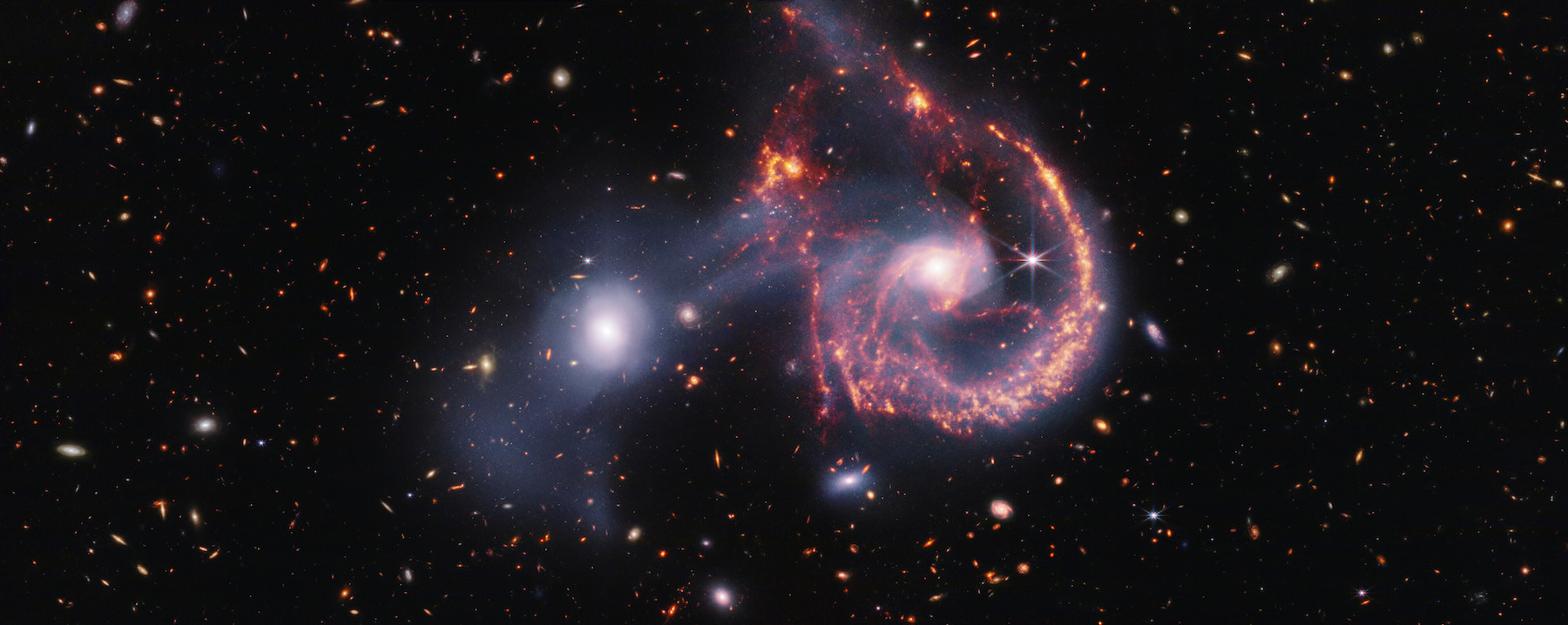
This composite image of Arp 107, created with data from two of the James Webb Space Telescope’s infrared instruments, reveals a wealth of information about the star formation taking place in these two galaxies and how they collided hundreds of million years ago. Credit: NASA, ESA, CSA, STScI
More than 600 scientists will review the proposals and select the most promising ones for time on Webb. The largest share of proposals would involve observing "high-redshift" galaxies among the first generation of galaxies that formed after the Big Bang. Galaxies this old and distant have their light stretched to longer wavelengths due to the expansion of the Universe. Research involving exoplanet atmospheres and stars and stellar populations were the second- and third-most popular science categories in this cycle.
Webb is a joint project of NASA, the European Space Agency, and the Canadian Space Agency. The observatory's 21.3-foot (6.5-meter) primary mirror and four infrared instruments, tuned to detect faint thermal energy coming from the cold blackness of space, make it a particularly useful general-purpose research platform. In this cycle, astronomers asked for time on Webb to look at targets within the Solar System, exoplanets in our stellar neighborhood, gas and dust suspended in the space between the stars, supermassive black holes, and nearby galaxies.
This is a remarkable range of scientific targets. Only the Hubble Space Telescope can match the breadth of Webb's scientific targets, but Webb's larger mirror allows it to observe objects 100 times fainter than Hubble can see.
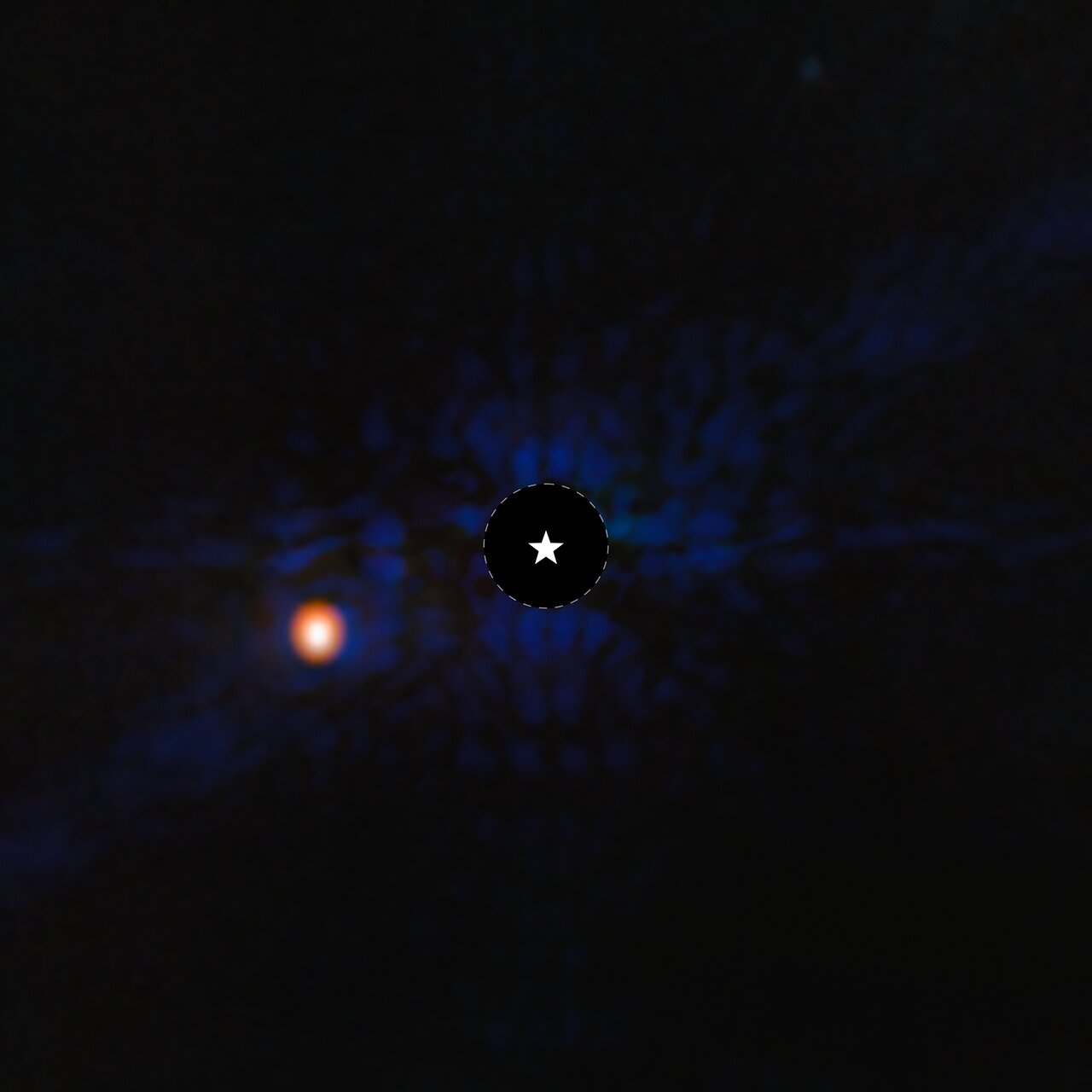
This image of the gas-giant exoplanet Epsilon Indi Ab was taken with the coronagraph on the James Webb Space Telescope’s Mid-Infrared Instrument A star symbol marks the location of the host star Epsilon Indi A, whose light has been blocked by the coronagraph. Credit: ESA/Webb, NASA, CSA, STScI, E. Matthews (Max Planck Institute for Astronomy)
In less than two-and-a-half years of science operations, Webb has only teased astronomers of its potential productivity. There is a high probability that Webb will see galaxies even older and more distant than the faint red beacon announced in May. There are thousands more known exoplanets for Webb to study, worlds of all sizes in our own Solar System, and unspeakable grandeur Webb will assuredly reveal in the years ahead.
It seems astronomers have no shortage of ideas about where to look. Maybe one day, new super heavy-lift rockets or advancements in in-space assembly will make it possible to deploy space telescopes even more sensitive than Webb. Until then, we can be thankful that Webb is performing well and has a good shot of far outliving its original five-year design life. Let's continue enjoying the show.
Stephen Clark Space Reporter
Stephen Clark is a space reporter at Ars Technica, covering private space companies and the world’s space agencies. Stephen writes about the nexus of technology, science, policy, and business on and off the planet.
The Conversation
November 6, 2024
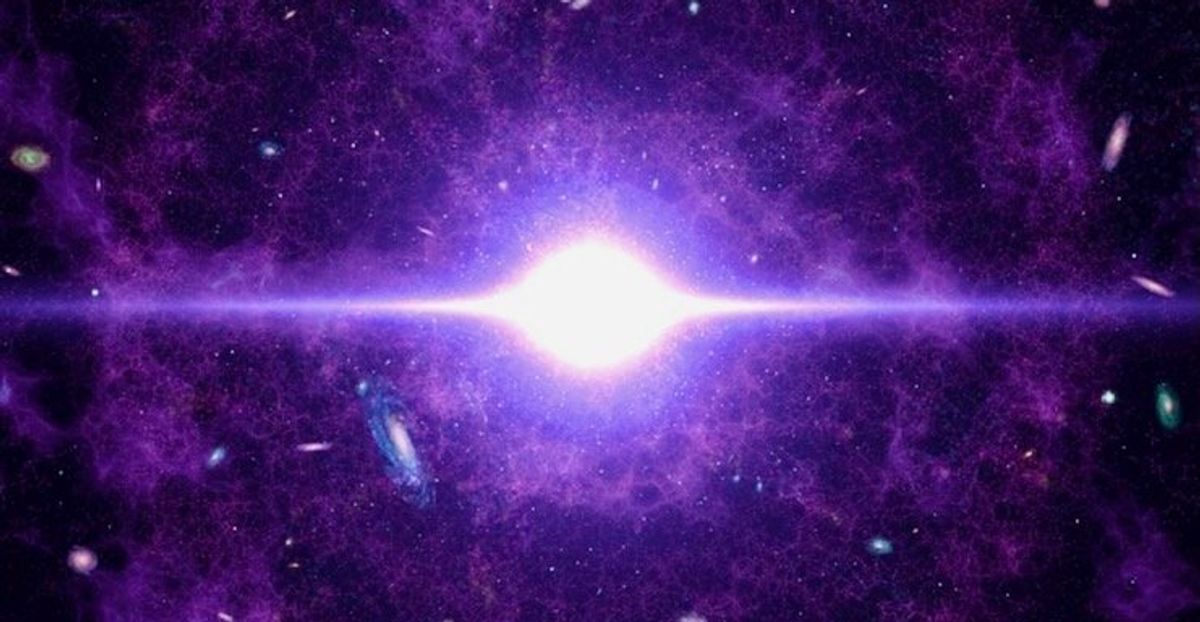
NASA's Goddard Space Flight Center/CI Lab
How did everything begin? It’s a question that humans have pondered for thousands of years. Over the last century or so, science has homed in on an answer: the Big Bang.
This describes how the Universe was born in a cataclysmic explosion almost 14 billion years ago. In a tiny fraction of a second, the observable universe grew by the equivalent of a bacterium expanding to the size of the Milky Way. The early universe was extraordinarily hot and extremely dense. But how do we know this happened?
Let’s look first at the evidence. In 1929, the American astronomer Edwin Hubble discovered that distant galaxies are moving away from each other, leading to the realisation that the universe is expanding. If we were to wind the clock back to the birth of the cosmos, the expansion would reverse and the galaxies would fall on top of each other 14 billion years ago. This age agrees nicely with the ages of the oldest astronomical objects we observe.
The idea was initially met with scepticism – and it was actually a sceptic, the English astronomer Fred Hoyle, who coined the name. Hoyle sarcastically dismissed the hypothesis as a “Big Bang” during an interview with BBC radio on March 28 1949.
This is article is part of our series Cosmology in crisis? which uncovers the greatest problems facing cosmologists today – and discusses the implications of solving them.
Then, in 1964, Arno Penzias and Robert Wilson detected a particular type of radiation that fills all of space. This became known as the cosmic microwave background (CMB) radiation. It is a kind of afterglow of the Big Bang explosion, released when the cosmos was a mere 380,000 years old.
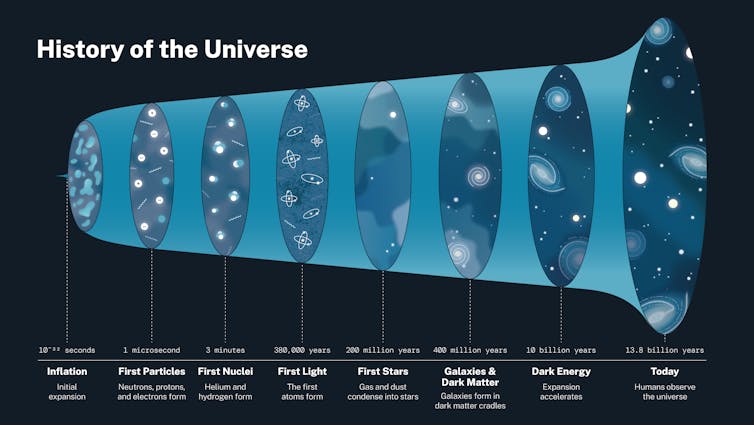
NASA
The CMB provides a window into the hot, dense conditions at the beginning of the universe. Penzias and Wilson were awarded the 1978 Nobel Prize in Physics for their discovery.
More recently, experiments at particle accelerators like the Large Hadron Collider (LHC) have shed light on conditions even closer to the time of the Big Bang. Our understanding of physics at these high energies suggests that, in the very first moments after the Big Bang, the four fundamental forces of physics that exist today were initially combined in a single force.
The present day four forces are gravity, electromagnetism, the strong nuclear force and the weak nuclear force. As the universe expanded and cooled down, a series of dramatic changes, called phase transitions (like the boiling or freezing of water), separated these forces.
Experiments at particle accelerators suggest that a few billionths of a second after the Big Bang, the latest of these phase transitions took place. This was the breakdown of electroweak unification, when electromagnetism and the weak nuclear force ceased to be combined. This is when all the matter in the Universe assumed its mass.
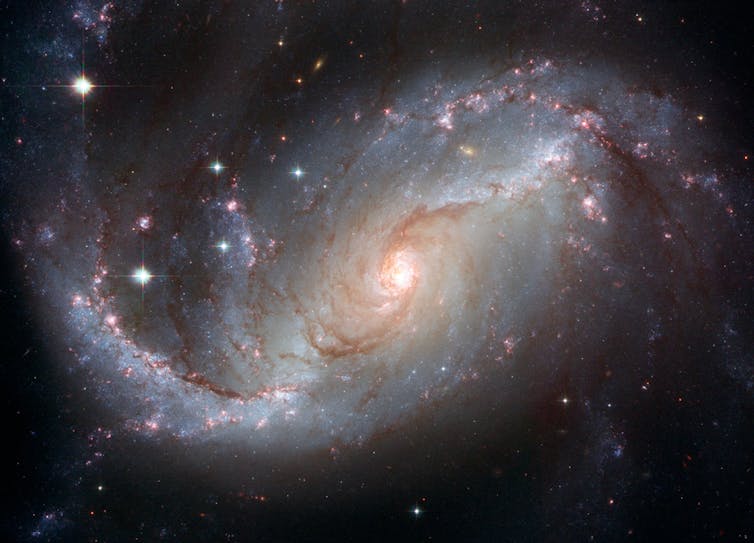
Edwin Hubble discovered that galaxies were moving away from one another. NASA, ESA, and The Hubble Heritage Team (STScI/AURA)-ESA/Hubble Collaboration
Moving on further in time, the universe is filled with a strange substance called quark-gluon plasma. As the name suggests, this “primordial soup” was made up of quarks and gluons. These are sub-atomic particles that are responsible for the strong nuclear force. Quark-gluon plasma was artificially generated in 2010 at the Brookhaven National Laboratory and in 2015 at the LHC.
Quarks and gluons have a strong attraction for one other and today are bound together as protons and neutrons, which in turn are the building blocks of atoms. However, in the hot and dense conditions of the early universe, they existed independently.
The quark-gluon plasma didn’t last long. Just a few millionths of a second after the Big Bang, as the universe expanded and cooled, quarks and gluons clumped together as protons and neutrons, the situation that persists today. This event is called quark confinement.
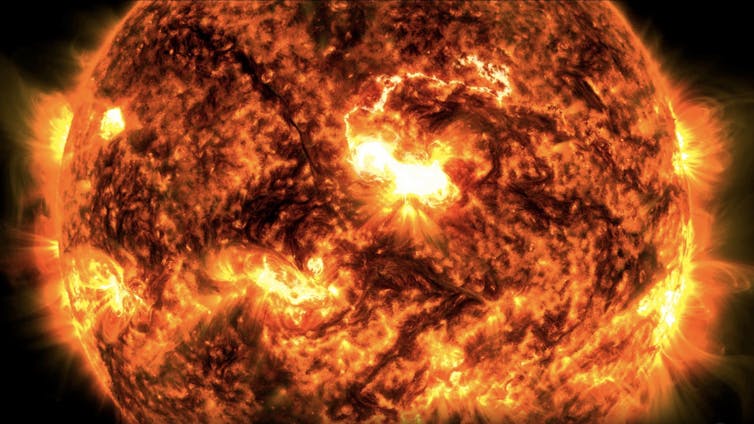
The early universe was extremely hot and dense, much like the centre of the Sun. NASA/SDO
As the universe expanded and cooled still further, there were fewer high energy photons (particles of light) in the universe than there had previously been. This is a trigger for the process called Big Bang nucleosynthesis (BBN). This is when the first atomic nuclei – the dense lumps of matter made of protons and neutrons and found at the centres of atoms – formed through nuclear fusion reactions, like those that power the Sun.
Back when there were more high energy photons in the universe, any atomic nuclei that formed would have been quickly destroyed by them (a process called photodisintegration). BBN ceased just a few minutes after the Big Bang, but its consequences are observable today.
Observations by astronomers have provided us with evidence for the primordial abundances of elements produced in these fusion reactions. The results closely agree with the theory of BBN. If we continued on, over nearly 14 billion years of time, we would reach the situation that exists today. But how close can we get to understanding what was happening near the moment of the Big Bang itself?
Scientists have no direct evidence for what came before the breakdown of electroweak unification (when electromagnetism and the weak nuclear force ceased to be combined). At such high energies and early times, we can only stare at the mystery of the Big Bang. So what does theory suggest?
When we go backwards in time through the history of the cosmos, the distances and volumes shrink, while the average energy density grows. At the Big Bang, distances and volumes drop to zero, all parts of the universe fall on top of each other and the energy density of the universe becomes infinite. Our mathematical equations, which describe the evolution of space and the expansion of the cosmos, become infested by zeros and infinities and stop making sense.
We call this a singularity. Albert Einstein’s theory of general relativity describes how spacetime is shaped. Spacetime is a way of describing the three-dimensional geometry of the universe, blended with time. A curvature in spacetime gives rise to gravity.
But mathematics suggests there are places in the universe where the curvature of spacetime becomes unlimited. These locations are known as singularities. One such example can be found at the centre of a black hole. At these places, the theory of general relativity breaks down.
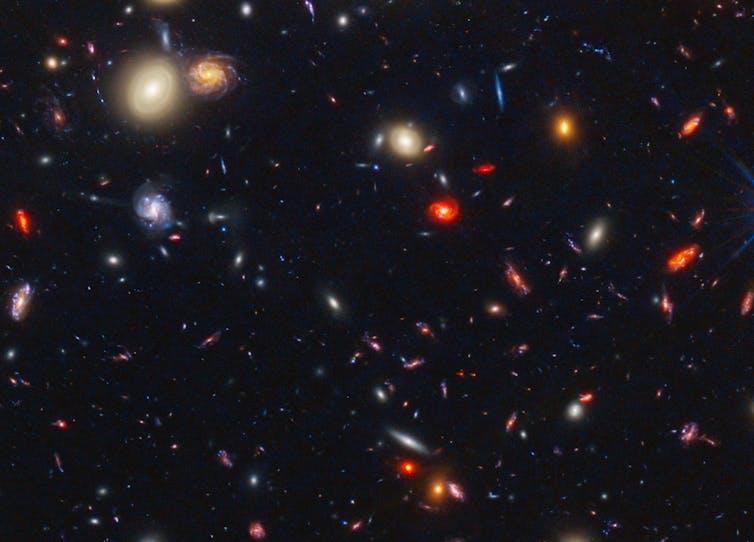
The universe cooled as it continued to expand. NASA, ESA, CSA, STScI, J. Diego (Instituto de Física de Cantabria, Spain), J. D’Silva (U. Western Australia), A. Koekemoer (STScI), J. Summers & R. Windhorst (ASU), and H. Yan (U. Missouri).
From 1965 to 1966, the British theoretical physicists Stephen Hawking and Roger Penrose presented a number of mathematical theorems demonstrating that the spacetime of an expanding universe must end at a singularity in the past: the Big Bang singularity.
Penrose received the Nobel Prize in 2020. Hawking passed away in 2018 and Nobel Prizes are not awarded posthumously. Space and time appear at the Big Bang singularity, so questions of what happens “before” the Big Bang are not well defined. As far as science can tell, there is no before; the Big Bang is the onset of time.
However, nature is not accurately described by general relativity alone, even though the latter has been around for more than 100 years and has not been disproven. General relativity cannot describe atoms, nuclear fusion or radioactivity. These phenomena are instead addressed by quantum theory.
Theories from “classical” physics, such as relativity, are deterministic. This means that certain initial conditions have a definite outcome and are therefore absolutely predictive. Quantum theory, on the other hand, is probabilistic. This means that certain initial conditions in the universe can have multiple outcomes.
Quantum theory is somewhat predictive, but in a probabilistic way. Outcomes are assigned a probability of existing. If the mathematical distribution of probabilities is sharply peaked at a certain outcome, then the situation is well described by a “classical” theory such as general relativity. But not all systems are like this. In some systems, for example atoms, the probability distribution is spread out and a classical description does not apply.
What about gravity? In the vast majority of cases, gravity is well described by classical physics. Classical spacetime is smooth. However, when curvature becomes extreme, near a singularity, then the quantum nature of gravity cannot be ignored. Here, spacetime is no longer smooth, but gnarly, similar to a carpet which looks smooth from afar but up-close is full of fibres and threads.
Thus, near the Big Bang singularity, the structure of spacetime ceases to be smooth. Mathematical theorems suggest that spacetime becomes overwhelmed by “gnarly” features: hooks, loops and bubbles. This rapidly fluctuating situation is called spacetime foam.
In spacetime foam, causality does not apply, because there are closed loops in spacetime where the future of an event is also its past (so its outcome can also be its cause). The probabilistic nature of quantum theory suggests that, when the probability distribution is evenly spread out, all outcomes are equally possible and the comfortable notion of causality we associate with a classical understanding of physics is lost.
Therefore, if we go back in time, just before we encounter the Big Bang singularity, we find ourselves entering an epoch where the quantum effects of gravity are dominant and causality does not apply. This is called the Planck epoch.
Time ceases to be linear, going from the past to the future, and instead becomes wrapped, chaotic and random. This means the question “why did the Big Bang occur?” has no meaning, because outside causality, events do not need a cause to take place.
In order to understand how physics works at a singularity like the Big Bang, we need a theory for how gravity behaves according to quantum theory. Unfortunately, we do not have one. There are a number of efforts on this front like loop quantum gravity and string theory, with its various incarnations.
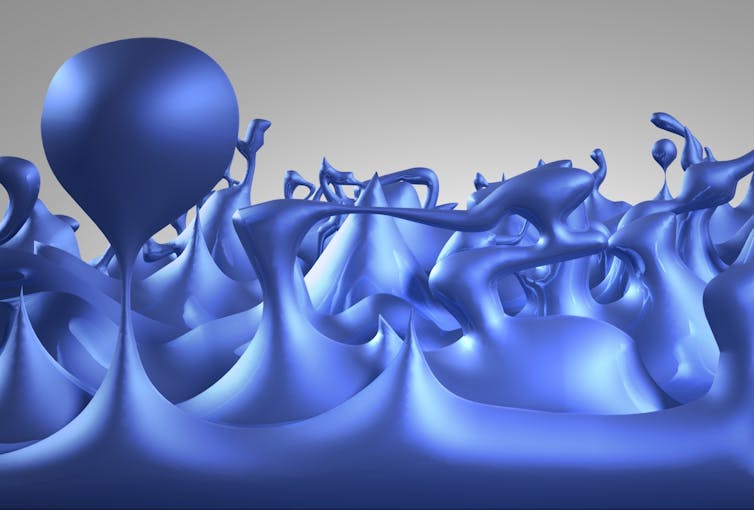
Near the Big Bang singularity, spacetime takes on a structure similar to foam. NASA/CXC/M.Weiss
However, these efforts are at best incomplete, because the problem is notoriously difficult. This means that spacetime foam has a totemic, powerful mystique, much like the ancient Chaos of Hesiod which the Greeks believed existed in the beginning.
So how did our expanding and largely classical universe ever escape from spacetime foam? This brings us to cosmic inflation. The latter is defined as a period of accelerated expansion in the early universe. It was first introduced by the Russian theoretical physicist Alexei Starobinsky in 1980 and in parallel, that same year, by the American physicist Alan Guth, who coined the name.
Inflation makes the universe large and uniform, according to observations. It also forces the universe to be spatially flat, which is an otherwise unstable situation, but which has also been confirmed by observations. Moreover, inflation provides a natural mechanism to generate the primordial irregularities in the density of the universe that are essential for structures such as galaxies and galaxy clusters to form.
Theory vindicated
Precision observations of the cosmic microwave background in recent decades have spectacularly confirmed the predictions of inflation. We also know that the universe can indeed undergo accelerated expansion, because in the last few billion years it started doing it again.
What does this have to do with spacetime foam? Well, it turns out that, if the conditions for inflation arise (by chance) in a patch of fluctuating spacetime, as can occur with spacetime foam, then this region inflates and starts conforming to classical physics.
According to an idea first proposed by the Russian-American physicist Andrei Linde, inflation is a natural – and perhaps inevitable – consequence of chaotic initial conditions in the early universe.
The point is that our classical universe could have emerged from chaotic conditions, like those in spacetime foam, by experiencing an initial boost of inflation. This would have set off the expansion of the universe. In fact, the observations by astronomers of the CMB suggest that the initial boost is explosive, since the expansion is exponential during inflation.
In March 20 of 2014, Alan Guth explained it succinctly: “I usually describe inflation as a theory of the ‘bang’ of the Big Bang: It describes the propulsion mechanism that we call the Big Bang.”
So, there you have it. The 14 billion year story of our universe begins with a cataclysmic explosion everywhere in space, which we call the Big Bang. That much is beyond reasonable doubt. This explosion is really a period of explosive expansion, which we call cosmic inflation. What happens before inflation, though? Is it a spacetime singularity, is it spacetime foam? The answer is largely unknown.
In fact, it might even be unknowable, because there is a mathematical theorem which forbids us from accessing information about the onset of inflation, much like the one that prevents us from knowing about the interiors of black holes. So, from our point of view, cosmic inflation is the Big Bang, the explosion that started it all.

Konstantinos Dimopoulos, Professor in Particle Cosmology, Lancaster University
This article is republished from The Conversation under a Creative Commons license. Read the original article.
NASA runs first engine tests on supersonic X-59 research aircraft

NASA's X-59 quiet supersonic research aircraft, pictured on Dec. 12, sits on the apron outside Lockheed Martin's Skunk Works facility in Palmdale, Calif.
Nov. 6 (UPI) -- NASA engineers fired the engines on the X-59 research aircraft in advance of planned test flights to determine if the aircraft can reduce sonic booms and make supersonic flight over land quieter.
Engineers began test-firing the experimental aircraft's jet engine at the Lockheed Martin Skunk Works facility in Palmdale, Calif., on Oct. 30 to see if the aircraft's systems work properly while the engine is in use before its inaugural test flight sometime in the near future.
The single-engine aircraft that Lockheed Martin designed and built is the research aircraft for NASA's Quiet SuperSonic Technology mission that NASA officials refer to as the Quesst mission. NASA first unveiled the experimental aircraft on Jan. 12.
The mission's intent is to make supersonic flight quieter and safer over residential areas.
The experimental aircraft has a very long needle-like nose with no windshield due to the inability of pilot to see what is below the nose.
The X-59's nose accounts for 38 feet of its 99.7 foot length, and pilots will use an External Vision System that uses forward-facing cameras linked to cockpit displays to enable its lone pilot to safely fly the aircraft
The aircraft's delta-shaped wings give it a wingspan of 29.5 feet, and it has a maximum takeoff weight of 32,300 pounds.
General Electric Aviation designed and built the engine that is expected to enable the X-59 to fly at up to 925 mph, which is equal to Mach 1.4, with a maximum altitude of 55,000 feet.
Instead of causing a loud sonic boom while flying over land, the aircraft is supposed to produce more of a soft thud.
NASA pilots will fly the aircraft over between four and six residential areas in 2026 and record data on how the public experiences the sonic disturbances caused while the aircraft exceeds the speed of sound.
NASA will ask residents of respective flyover communities their impression of the X-59 and the amount of noise it produces.
Mighty radio bursts linked to massive galaxies
Results from Caltech's Deep Synoptic Array-110 provide new clues about how magnetars form
image:
This photo montage shows the antennas of the Deep Synoptic Array-110, which are used to discover and pinpoint the locations of fast radio bursts (FRBs). Above the antennas are images of some of the FRB host galaxies as they appear on the sky. The galaxies are remarkably large, challenging models that describe FRB sources.
view moreCredit: Annie Mejia/Caltech
Since their discovery in 2007, fast radio bursts—extremely energetic pulses of radio-frequency light—have lit up the sky repeatedly, leading astronomers on a chase to uncover their origins. Currently, confirmed fast radio bursts, or FRBs, number in the hundreds, and scientists have assembled mounting evidence for what triggers them: highly magnetized neutron stars known as magnetars (neutron stars are a type of dead star). One key piece of evidence came when a magnetar erupted in our own galaxy and several observatories, including Caltech's STARE2 (Survey for Transient Astronomical Radio Emission 2) project, caught the actionin real time.
Now, reporting in the journal Nature, Caltech-led researchers have uncovered where FRBs are more likely to occur in the universe—massive star-forming galaxies rather than low-mass ones. This finding has, in turn, led to new ideas about how magnetars themselves form. Specifically, the work suggests that these exotic dead stars, whose magnetic fields are 100 trillion times stronger than Earth's, often form when two stars merge and later blow up in a supernova. Previously, it was unclear whether magnetars form in this way, from the explosion of two merged stars, or whether they might form when a single star explodes.
"The immense power output of magnetars makes them some of the most fascinating and extreme objects in the universe," says Kritti Sharma, lead author of the new study and a graduate student working with Vikram Ravi, an assistant professor of astronomy at Caltech. "Very little is known about what causes the formation of magnetars upon the death of massive stars. Our work helps to answer this question."
The project began with a search for FRBs using the Deep Synoptic Array-110 (DSA-110), a Caltech project funded by the National Science Foundation and based at the Owens Valley Radio Observatory near Bishop, California. To date, the sprawling radio array has detected and localized 70 FRBs to their specific galaxy of origin (only 23 other FRBs have been localized by other telescopes). In the current study, the researchers analyzed 30 of these localized FRBs.
"DSA-110 has more than doubled the number of FRBs with known host galaxies," says Ravi. "This is what we built the array to do."
Although FRBs are known to occur in galaxies that are actively forming stars, the team, to its surprise, found that the FRBs tend to occur more often in massive star-forming galaxies than low-mass star-forming galaxies. This alone was interesting because the astronomers had previously thought that FRBs were going off in all types of active galaxies.
With this new information, the team started to ponder what the results revealed about FRBs. Massive galaxies tend to be metal-rich because the metals in our universe—elements that are manufactured by stars—take time to build up over the course of cosmic history. The fact that FRBs are more common in these metal-rich galaxies implies that the source of FRBs, magnetars, are also more common to these types of galaxies.
Stars that are rich in metals—which in astronomical terms means elements heavier than hydrogen and helium—tend to grow larger than other stars. "Over time, as galaxies grow, successive generations of stars enrich galaxies with metals as they evolve and die," Ravi says.
What is more, massive stars that explode in supernovae and can become magnetars are more commonly found in pairs. In fact, 84 percent of massive stars are binaries. So, when one massive star in a binary is puffed up due to extra metal content, its excess material gets yanked over to its partner star, which facilitates the ultimate merger of the two stars. These merged stars would have a greater combined magnetic field than that of a single star.
"A star with more metal content puffs up, drives mass transfer, culminating in a merger, thus forming an even more massive star with a total magnetic field greater than what the individual star would have had," Sharma explains.
In summary, since FRBs are preferentially observed in massive and metal-rich star-forming galaxies, then magnetars (which are thought to trigger FRBs) are probably also forming in metal-rich environments conducive to the merging of two stars. The results therefore hint that magnetars across the universe originate from the remnants of stellar mergers.
In the future, the team hopes to hunt down more FRBs and their places of origin using DSA-110, and eventually the DSA-2000, an even bigger radio array planned to be built in the Nevada desert and completed in 2028.
"This result is a milestone for the whole DSA team. A lot of the authors on this paper helped build the DSA-110," Ravi says. "And the fact that the DSA-110 is so good at localizing FRBs bodes well for the success of DSA-2000."
The paper is titled "Preferential Occurrence of Fast Radio Bursts in Massive Star-Forming Galaxies." Other Caltech authors include Liam Connor, Casey Law, Stella Koch Ocker, Myles Sherman, Nikita Kosogorov, Jakob Faber, Gregg Hallinan, Charlie Harnach, Greg Hellbourg, Rick Hobbs, David Hodge, Mark Hodges, James Lamb, Paul Rasmussen, Jean Somalwar, Sander Weinreb, David Woody, Shreya Anand, Kaustav Kashyap Das, Yu-Jing Qin, Sam Rose, Dillon Z. Dong, Jessie Miller, and Yuhan Yao. Joel Leja from The Pennsylvania State University is also an author.
Journal
Nature
Asteroid grains shed light on the outer solar system’s origins
A weak magnetic field likely pulled matter inward to form the outer planetary bodies, from Jupiter to Neptune.
image:
MIT scientists analyzed one of several particles (shown in black) from the asteroid Ryugu, and found evidence that a weak magnetic field likely existed in the outer solar system where the asteroid is thought to have first formed, more than 4.6 billion years ago.
view more
Credit: Elias Mansbach
Tiny grains from a distant asteroid are revealing clues to the magnetic forces that shaped the far reaches of the solar system over 4.6 billion years ago.
Scientists at MIT and elsewhere have analyzed particles of the asteroid Ryugu, which were collected by the Japanese Aerospace Exploration Agency’s (JAXA) Hayabusa2 mission and brought back to Earth in 2020. Scientists believe Ryugu formed on the outskirts of the early solar system before migrating in toward the asteroid belt, eventually settling into an orbit between Earth and Mars.
The team analyzed Ryugu’s particles for signs of any ancient magnetic field that might have been present when the asteroid first took shape. Their results suggest that if there was a magnetic field, it would have been very weak. At most, such a field would have been about 15 microtesla. (The Earth’s own magnetic field today is around 50 microtesla.)
Even so, the scientists estimate that such a low-grade field intensity would have been enough to pull together primordial gas and dust to form the outer solar system’s asteroids and potentially play a role in giant planet formation, from Jupiter to Neptune.
The team’s results, which are published today in the journal AGU Advances, show for the first time that the distal solar system likely harbored a weak magnetic field. Scientists have known that a magnetic field shaped the inner solar system, where Earth and the terrestrial planets were formed. But it was unclear whether such a magnetic influence extended into more remote regions, until now.
“We’re showing that, everywhere we look now, there was some sort of magnetic field that was responsible for bringing mass to where the sun and planets were forming,” says study author Benjamin Weiss, the Robert R. Shrock Professor of Earth and Planetary Sciences at MIT. “That now applies to the outer solar system planets.”
The study’s lead author is Elias Mansbach PhD ’24, who is now a postdoc at Cambridge University. MIT co-authors include Eduardo Lima, Saverio Cambioni, and Jodie Ream, along with Michael Sowell and Joseph Kirschvink of Caltech, Roger Fu of Harvard University, Xue-Ning Bai of Tsinghua University, Chisato Anai and Atsuko Kobayashi of the Kochi Advanced Marine Core Research Institute, and Hironori Hidaka of Tokyo Institute of Technology.
A far-off field
Around 4.6 billion years ago, the solar system formed from a dense cloud of interstellar gas and dust, which collapsed into a swirling disk of matter. Most of this material gravitated toward the center of the disk to form the sun. The remaining bits formed a solar nebula of swirling, ionized gas. Scientists suspect that interactions between the newly formed sun and the ionized disk generated a magnetic field that threaded through the nebula, helping to drive accretion and pull matter inward to form the planets, asteroids, and moons.
“This nebular field disappeared around 3 to 4 million years after the solar system’s formation, and we are fascinated with how it played a role in early planetary formation,” Mansbach says.
Scientists previously determined that a magnetic field was present throughout the inner solar system — a region that spanned from the sun to about 7 astronomical units (AU), out to where Jupiter is today. (One AU is the distance between the sun and the Earth.) The intensity of this inner nebular field was somewhere between 50 to 200 microtesla, and it likely influenced the formation of the inner terrestrial planets. Such estimates of the early magnetic field are based on meteorites that landed on Earth and are thought to have originated in the inner nebula.
“But how far this magnetic field extended, and what role it played in more distal regions, is still uncertain because there haven’t been many samples that could tell us about the outer solar system,” Mansbach says.
Rewinding the tape
The team got an opportunity to analyze samples from the outer solar system with Ryugu, an asteroid that is thought to have formed in the early outer solar system, beyond 7 AU, and was eventually brought into orbit near the Earth. In December 2020, JAXA’s Hayabusa 2 mission returned samples of the asteroid to Earth, giving scientists a first look at a potential relic of the early distal solar system.
The researchers acquired several grains of the returned samples, each about a millimeter in size. They placed the particles in a magnetometer — an instrument in Weiss’ lab that measures the strength and direction of a sample’s magnetization. They then applied an alternating magnetic field to progressively demagnetize each sample.
“Like a tape recorder, we are slowly rewinding the sample’s magnetic record,” Mansbach explains. “We then look for consistent trends that tell us if it formed in a magnetic field.”
They determined that the samples held no clear sign of a preserved magnetic field. This suggests that either there was no nebular field present in the outer solar system where the asteroid first formed, or the field was so weak that it was not recorded in the asteroid’s grains. If the latter is the case, the team estimates such a weak field would have been no more than 15 microtesla in intensity.
The researchers also reexamined data from previously studied meteorites. They specifically looked at “ungrouped carbonaceous chondrites” — meteorites that have properties that are characteristic of having formed in the distal solar system. Scientists had estimated the samples were not old enough to have formed before the solar nebula disappeared. Any magnetic field record the samples contain, then, would not reflect the nebular field. But Mansbach and his colleagues decided to take a closer look.
“We reanalyzed the ages of these samples and found they are closer to the start of the solar system than previously thought,” Mansbach says. “We think these samples formed in this distal, outer region. And one of these samples does actually have a positive field detection of about 5 microtesla, which is consistent with an upper limit of 15 microtesla.”
This updated sample, combined with the new Ryugu particles, suggest that the outer solar system, beyond 7 AU, hosted a very weak magnetic field, that was nevertheless strong enough to pull matter in from the outskirts to eventually form the outer planetary bodies, from Jupiter to Neptune.
“When you’re further from the sun, a weak magnetic field goes a long way,” Weiss notes. “It was predicted that it doesn’t need to be that strong out there, and that’s what we’re seeing.”
The team plans to look for more evidence of distal nebular fields with samples from another far-off asteroid, Bennu, which were delivered to Earth in September 2023 by NASA’s OSIRIS-REx spacecraft.
“Bennu looks a lot like Ryugu, and we’re eagerly awaiting first results from those samples,” Mansbach says.
This research was supported, in part, by NASA.
###
Written by Jennifer Chu, MIT News
Paper: “Evidence for Magnetically-Driven Accretion in the Distal Solar System”
https://agupubs.onlinelibrary.wiley.com/doi/10.1029/2024AV001396
Journal
AGU Advances
Article Title
Evidence for Magnetically-Driven Accretion in the Distal Solar System”
Interstellar methane as progenitor of amino acids?
Gamma radiation converts methane into glycine and other complex molecules
Wiley
Gamma radiation can convert methane into a wide variety of products at room temperature, including hydrocarbons, oxygen-containing molecules, and amino acids, reports a research team in the journal Angewandte Chemie. This type of reaction probably plays an important role in the formation of complex organic molecules in the universe—and possibly in the origin of life. They also open up new strategies for the industrial conversion of methane into high value-added products under mild conditions.
With these research results, the team led by Weixin Huang at the University of Science and Technology of China (Hefei) has contributed to our fundamental understanding of the early development of molecules in the universe. “Gamma rays, high-energy photons commonly existing in cosmic rays and unstable isotope decay, provide external energy to drive chemical reactions of simple molecules in the icy mantles of interstellar dust and ice grains,” states Huang. “This can result in more complex organic molecules, presumably starting from methane (CH4), which is widely present throughout the interstellar medium.”
Although higher pressures and temperatures reign on Earth and on planets in the so-called habitable zone, most studies of cosmic processes are only simulated under vacuum and at extremely low temperatures. In contrast, the Chinese team studied the reactions of methane at room temperature in the gas and aqueous phases under irradiation with a cobalt-60 emitter.
The composition of the products varies depending on the starting materials. Pure methane reacts—with very low yield—to give ethane, propane and hydrogen. The addition of oxygen increases the conversion, resulting mainly in CO2 as well as CO, ethylene, and water. In the presence of water, aqueous methane reacts to give acetone and tertiary butyl alcohol; in the gas phase, it gives ethane and propane. When both water and oxygen are added, the reactions are strongly accelerated. In the aqueous phase, formaldehyde, acetic acid, and acetone are formed. If ammonia is also added, acetic acid forms glycine, an amino acid also found in space. “Under gamma radiation, glycine can be made from methane, oxygen, water, and ammonia, molecules that are found in large amounts in space,” says Huang. The team developed a reaction scheme that explains the routes by which the individual products are formed. Oxygen (∙O2−) and ∙OH radicals play an important role in this. The rates of these radical reaction mechanisms are not temperature-dependent and could thus also take place in space.
In addition, the team was able to demonstrate that various solid particles that are components of interstellar dust—silicon dioxide, iron oxide, magnesium silicate, and graphene oxide—change the product selectivity in different ways. The varied composition of interstellar dust may thus have contributed to the observed uneven distribution of molecules in space.
Silicon dioxide leads to a more selective conversion of methane to acetic acid. Says Huang, “because gamma radiation is an easily available, safe, and sustainable source of energy, this could be a new approach for using methane as a carbon source that can be efficiently converted into value-added products under mild conditions—a long-standing challenge for industrial synthetic chemistry.”
(3427 characters)
About the Author
Dr Weixin Huang is the Changjiang Professor in Physical Chemistry at USTC appointed by the Ministry of Education of China. His research focuses on surface chemistry and catalysis of solid catalysts with well-defined structures.
Journal
Angewandte Chemie International Edition
Method of Research
Experimental study
Subject of Research
Not applicable
Article Title
γ-Ray Driven Aqueous-Phase Methane Conversions into Complex Molecules up to Glycine

